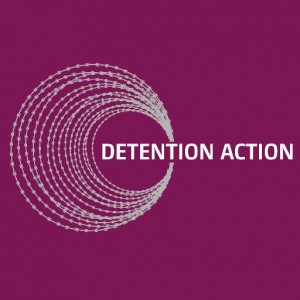Asylum rights campaigners and human rights lawyers are celebrating the suspension of the detained fast track – and gearing up to resume battle over a ‘reformed’ version.
On 2 July, immigration minister James Brokenshire announced the suspension of fast-track detention of asylum seekers. In a historic victory for asylum rights campaigners, he acknowledged the ‘significant’ legal challenges that had seen the Detained Fast Track (DFT) declared unlawful on three occasions in the past year (with the imminent prospect of a fourth), and recognised an unacceptably high risk of unfairness to ‘certain vulnerable applicants’. But as Brokenshire also made clear, the government remains committed in principle to the DFT to ‘prevent abuse of asylum’ by speedy determination of ‘weak’ claims, and a revamped system is expected in the autumn.
What is the Detained Fast Track?
The DFT is a damaging and structurally unfair process for disposing speedily of as many asylum claims as possible without actually renouncing the UK’s obligations under the Refugee Convention. Its origins lie in the New Labour administration’s panicked response to increased numbers of asylum claimants entering Britain – approaching 100,000 a year by 2000. As the media and the Right whipped up hysteria about ‘bogus’ asylum seekers, ministers devised a scheme to detain those whose claims could be decided quickly, with selection initially based mainly on nationality, targeting nationals of fifty-five ‘safe’ countries, although anyone whose claim was deemed straightforward could be detained.  In practice, this meant those whose claims could quickly be refused; detention and hugely accelerated processing of applications was seen by ministers as an efficient way of disposing of claims deemed ‘bogus’,while sending a clear deterrent message to those embarking on the journey to Britain. Those selected for fast-track processing were sent to Oakington barracks in Cambridgeshire (refurbished for the purpose in 2000), where their claim was decided in about a week (asylum seekers were released following the decision, pending appeal).
In practice, this meant those whose claims could quickly be refused; detention and hugely accelerated processing of applications was seen by ministers as an efficient way of disposing of claims deemed ‘bogus’,while sending a clear deterrent message to those embarking on the journey to Britain. Those selected for fast-track processing were sent to Oakington barracks in Cambridgeshire (refurbished for the purpose in 2000), where their claim was decided in about a week (asylum seekers were released following the decision, pending appeal).
The idea of detaining asylum seekers purely for administrative convenience, and not because of any risk they might abscond, outraged asylum rights campaigners and human rights lawyers – but a legal challenge to the new system failed in the UK’s highest court and then in the European Court of Human Rights. [1] Encouraged by this judicial endorsement, in 2003 the government expanded the DFT system, extending it to the appeal process (which, like the initial decision, was accelerated), and applying it to an increasing proportion of asylum seekers, who were placed in Harmondsworth, Yarl’s Wood and Colnbrook immigration removal centres (IRCs). In time the nationality criterion was dropped, and anyone whose claim could be decided quickly could be detained.
Structural unfairness
The fast track was a product of the culture of disbelief permeating asylum procedures, and from the start, the proportion of fast-track claimants whose claims succeeded was tiny, around one percent. It was a self-fulfilling system which set claimants up for failure by imposing time limits which made it impossible to present claims and appeals fairly, and used the resultant dismal statistics to justify itself. The Refugee Legal Centre (which represented tens of thousands of asylum seekers until its death by a thousand legal aid cuts in 2010) brought a legal challenge in 2004, arguing that the DFT was too fast to be fair, but the Court of Appeal ruled that it was flexible enough to be lawful (claimants could be removed from DFT if their claims required further investigation).
 For the next decade, as numbers of asylum claimants began to fall to their current level of around 30,000 per year, asylum and human rights groups campaigned for the abolition of the detained fast track, condemning the structural unfairness of the system.[2] As the Immigration Law Practitioners’ Association (ILPA) pointed out in 2005, Home Office pre-detention screening was inadequate to identify ‘straightforward’ or ‘weak’ claims suitable for fast-tracking – very few questions were asked about the substance of the asylum claim, with officials far more interested to establish the routes by which claimants had managed to get to the UK. This meant that those with complex claims, often based on risks of violence based on gender or sexuality (such as war-related rape or FGM), or on being trafficked, were regularly put into the fast track, although their claims needed careful and thorough assessment.
For the next decade, as numbers of asylum claimants began to fall to their current level of around 30,000 per year, asylum and human rights groups campaigned for the abolition of the detained fast track, condemning the structural unfairness of the system.[2] As the Immigration Law Practitioners’ Association (ILPA) pointed out in 2005, Home Office pre-detention screening was inadequate to identify ‘straightforward’ or ‘weak’ claims suitable for fast-tracking – very few questions were asked about the substance of the asylum claim, with officials far more interested to establish the routes by which claimants had managed to get to the UK. This meant that those with complex claims, often based on risks of violence based on gender or sexuality (such as war-related rape or FGM), or on being trafficked, were regularly put into the fast track, although their claims needed careful and thorough assessment.
The human cost
The detention centres designated for fast-track claims soon became notorious for levels of self-harm and other indicators of despair and distress. The reason was that safeguards to prevent the detention of vulnerable claimants, such as survivors of torture, trafficking and other serious human rights abuses, simply did not work. They were undermined by the same culture of disbelief which produced the fast track. Screening interviews were not designed to elicit information about vulnerabilities which would preclude detention. But even when claimants revealed torture in screening, they were regularly routed into fast track, because Home Office guidance required ‘independent’ evidence of torture, not just survivors’ testimony. Claims of torture were not routinely followed up, despite detention centre rules requiring medical screening within twenty-four hours. A 2006 test case on the detention of torture survivors [3] found that this medical screening had not been carried out for years; the Home Office had unilaterally decided that routine medical screening of new arrivals was unnecessary, and so refused to pay the private healthcare provider for it – so it was not done. No apology was forthcoming for this blatant breach of the rules.
A 2011 Home Office audit of another safeguard for vulnerable detainees, ‘Rule 35’, found it was not working to secure their release from detention. Rule 35 of the detention rules required detention centre medical staff to report concerns over a detainee, such as indications of torture, a risk of suicide or self-harm, to Home Office officials, who were required to respond within 48 hours. The audit found that in one-third of cases, officials failed to respond to reports at all, and in another third of cases did so outside the legal timeframe, while only one in ten medical reports resulted in a detainee’s release. A joint report from the Independent Chief Inspector of Borders and Immigration (ICIBI) and HM Prisons Inspectorate, published in 2012, was highly critical of the ineffectiveness of safeguards against detention of vulnerable people. But nothing was done, and things only got worse.
The role of the Foundations
Detention often caused serious psychological damage, as the experience of detention made survivors of cruelty relive their initial trauma. With a system designed to shovel an ever higher proportion of asylum seekers into detention and to process their claims and appeals as fast as possible, without regard to considerations of fairness or vulnerability, the numbers of detainees needing specialist help from the Helen Bamber Foundation (HBF) or Freedom from Torture (FFT) (formerly the Medical Foundation for the Care of Victims of Torture) began to rise exponentially.
 The Foundations have a dual role vis-à-vis asylum seekers: they provide holistic therapy for the wounds caused by torture or (in the case of HBF) other serious human rights violations including trafficking, and they also provide expert medical evidence to assist the Home Office and the courts in determining claims of torture or ill-treatment. In recognition of their expertise, the Home Office agreed that detainees accepted for assessment by HBF or FFT would be released. This was for two reasons: acceptance meant there were indications of vulnerability, suggesting that the person might be a torture survivor with a claim that could not be dismissed quickly; and a full medico-legal report would take several months, meaning the claim was unsuitable for speedy determination.
The Foundations have a dual role vis-à-vis asylum seekers: they provide holistic therapy for the wounds caused by torture or (in the case of HBF) other serious human rights violations including trafficking, and they also provide expert medical evidence to assist the Home Office and the courts in determining claims of torture or ill-treatment. In recognition of their expertise, the Home Office agreed that detainees accepted for assessment by HBF or FFT would be released. This was for two reasons: acceptance meant there were indications of vulnerability, suggesting that the person might be a torture survivor with a claim that could not be dismissed quickly; and a full medico-legal report would take several months, meaning the claim was unsuitable for speedy determination.
 In 2011 and 2012, HBF was receiving around seven referrals a month from the DFT. By the end of 2013, this number had increased to over twenty a month; in 2014 it rose to forty-eight a month, rising later in the year to eighty and more. The huge increase in detained asylum seekers needing HBF’s services began to have serious effects on the charity as a whole. At the end of 2013, HBF was forced to close to community referrals in order to cope with the increase in referrals from DFT, whose cases were more urgent because of their detention. FFT too was seeing an increase in referrals from the fast track. As referrals continued rising in 2014, the situation was becoming untenable.
In 2011 and 2012, HBF was receiving around seven referrals a month from the DFT. By the end of 2013, this number had increased to over twenty a month; in 2014 it rose to forty-eight a month, rising later in the year to eighty and more. The huge increase in detained asylum seekers needing HBF’s services began to have serious effects on the charity as a whole. At the end of 2013, HBF was forced to close to community referrals in order to cope with the increase in referrals from DFT, whose cases were more urgent because of their detention. FFT too was seeing an increase in referrals from the fast track. As referrals continued rising in 2014, the situation was becoming untenable.
Legal bombardment
 Meanwhile, at the end of 2013 a sustained legal challenge to the DFT began – which culminated in its suspension at the beginning of July 2015. In December 2013, the campaigning and detainee support group Detention Action began a three-day High Court challenge to the legality of all aspects of the DFT. It took the High Court over six months to deliver its judgment, but in July 2014, the court ruled that the fast track’s very tight timetable created such a high risk of unfairness as to be unlawful. Detainees had so little time between meeting legal representatives and presenting their claim that claims could not be properly presented.[4] But the DFT was not suspended, as the Home Office claimed that in the interim, it had made changes to ensure greater fairness. The main change was a four-day period for legal representatives to help detainees prepare before the asylum interview.
Meanwhile, at the end of 2013 a sustained legal challenge to the DFT began – which culminated in its suspension at the beginning of July 2015. In December 2013, the campaigning and detainee support group Detention Action began a three-day High Court challenge to the legality of all aspects of the DFT. It took the High Court over six months to deliver its judgment, but in July 2014, the court ruled that the fast track’s very tight timetable created such a high risk of unfairness as to be unlawful. Detainees had so little time between meeting legal representatives and presenting their claim that claims could not be properly presented.[4] But the DFT was not suspended, as the Home Office claimed that in the interim, it had made changes to ensure greater fairness. The main change was a four-day period for legal representatives to help detainees prepare before the asylum interview.
Then, in December 2014, the Court of Appeal ruled unlawful the policy of blanket detention after the initial decision and pending appeal. Since the purpose of initial detention – the speedy determination of claims – had been fulfilled, there was no legal justification for continued detention, unless the detainee had been assessed as someone likely to abscond. This was a big blow to fast-track detention. Another blow came in June 2015, when the High Court ruled that the impossibly tight timetable for appeals in the fast track rendered them, too, structurally unfair.[6] At the hearing on 12 June, the Home Office persuaded the judge to stay the ruling, to give it time to implement changes – but two weeks later the Court of Appeal overruled the stay. So far as the appeal stage was concerned, the DFT was in tatters.
But it was the challenges to the detention of vulnerable asylum seekers such as torture survivors which were to deliver the coup de grace to the system.
Amassing evidence of failure
The judge giving the July 2014 judgment had accepted that the Home Office safeguards against the detention of vulnerable people – the screening interview, medical screening and Rule 35 procedure – did not work effectively. But he ruled that HBF and FFT’s work in providing pre-assessments, which the Home Office relied on to release vulnerable detainees, provided an effective safeguard (although, as the judge failed to point out, they were neither paid nor contracted to provide). In this respect, the judgment let the Home Office off the hook, and the result was that the Foundations became even more overwhelmed – particularly as legal representatives now had more time to see clients, note vulnerabilities and refer them for assessment.  By the end of the year, HBF was getting nearly 100 referrals a month and was offering appointments in 2017. It was unsustainable. HBF (the smaller charity but the one with a wider remit, so more profoundly affected by the DFT expansion) decided that, although it would continue to do paper assessments of detainees and would give its expert preliminary opinion on vulnerability, it could no longer offer pre-assessment appointments to detainees. The Home Office responded by refusing to release those without appointments. Four detainees, all of whom had been the subject of Rule 35 reports and assessed by HBF as prima facie torture survivors, but had remained in DFT, brought a test case, part of wider litigation involving twenty-seven vulnerable claimants held in the DFT. In March, a High Court order was obtained for their release pending the hearing of the challenge at the end of June. HBF filed evidence of a study it had undertaken of over 300 detainees referred to it since January. The evidence demonstrated that 92 percent of the detainees showed either direct references to or indicators of of torture or ill-treatment which had been ignored at screening, or in the Rule 35 process, or in the asylum interview. Ninety-two percent of detainees referred to HBF in 2015 should not have been detained.
By the end of the year, HBF was getting nearly 100 referrals a month and was offering appointments in 2017. It was unsustainable. HBF (the smaller charity but the one with a wider remit, so more profoundly affected by the DFT expansion) decided that, although it would continue to do paper assessments of detainees and would give its expert preliminary opinion on vulnerability, it could no longer offer pre-assessment appointments to detainees. The Home Office responded by refusing to release those without appointments. Four detainees, all of whom had been the subject of Rule 35 reports and assessed by HBF as prima facie torture survivors, but had remained in DFT, brought a test case, part of wider litigation involving twenty-seven vulnerable claimants held in the DFT. In March, a High Court order was obtained for their release pending the hearing of the challenge at the end of June. HBF filed evidence of a study it had undertaken of over 300 detainees referred to it since January. The evidence demonstrated that 92 percent of the detainees showed either direct references to or indicators of of torture or ill-treatment which had been ignored at screening, or in the Rule 35 process, or in the asylum interview. Ninety-two percent of detainees referred to HBF in 2015 should not have been detained.
With the date for the hearing approaching, no response came to this evidence. Finally, the day before the scheduled hearing, Home Office lawyers said they were not fighting the cases, and the minister would be announcing the suspension of the detained fast track since it led to an ‘unacceptable risk of unfairness to vulnerable claimants’. In an agreed Statement of Reasons, the Home Office accepted that the claimants were unlawfully detained and that the screening and Rule 35 procedures did not work. TJ Birdi, the director of HBF, said, ‘When the Detained Fast Track was introduced fifteen years ago, the Home Office promised that people who had been tortured would not be placed in detention. It failed to follow its own policy and, as a result, thousands of traumatised men and women were subjected to further unnecessary suffering.’
Where are we now?
Although the Home Office has suspended the detained fast track, the Ministry of Justice (which has responsibility for fast-track appeals) has indicated it is appealing the decision that fast-track appeals are unfair. Meanwhile, no new asylum seekers are being sent to fast-track detention, and those already in the system are being assessed for release.
But suspension of the DFT does not mean the release of all asylum seekers – as a new Home Office instruction to caseworkers emphasises – and although official policy says detention should be a last resort, the culture of disbelief, suspicion and contempt leads to over-use of detention just as it leads to the abuses in detention documented over the years – physical, sexual, emotional and racial.[6] In February, the Home Office commissioned former Prisons and Probation Ombudsman Stephen Shaw to review the welfare of vulnerable people in detention – but explicitly omitted the decision to detain from his terms of reference. Current Home Office policy allows the detention of even those with serious mental illness, provided their condition can be adequately ‘managed’ in detention – and the Home Office will brook no interference with this policy, however harmful it is for detainees.
Immigration removal centres are no place for vulnerable or traumatised people – as medical organisations including the Royal College of Psychiatrists have attested. The suspension of the detained fast track shows what can be achieved when civil society actors come together to challenge injustice. Campaigners and lawyers alike will be working hard to ensure that the DFT does not return without solid, reliable and verifiable safeguards which keep vulnerable people out of detention. But the legal marathon also proves the extent to which the Home Office will fight tooth and nail to retain structural injustice in the asylum system. Given the damage this structural injustice causes both to vulnerable people and to the asylum process, campaigners will be asking why the DFT should be brought back at all.
RELATED LINKS
IRR News story: ‘Immigration detention: signs of spring, or false dawn?’
IRR News story: ‘The real “immigration debate”‘
IRR briefing paper: ‘Europe’s pariah state? The future of human rights in Britain’

In Colnbrook and Harmsworth, yet Hundreds of vulnerable Asylum Seeker detained. The Home Office released Nearly 100 people since after the High Court Judgement. Yet nearly 700 people should be released in DFT. they face serious mental issue as they being detained, lose their health.
The High Court should put strong order to Home office to release them Immediately.